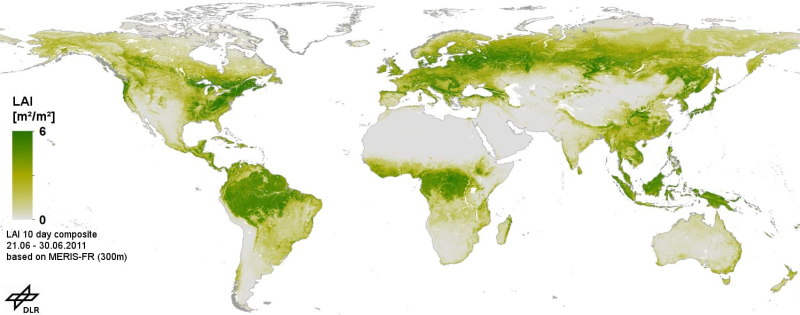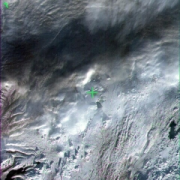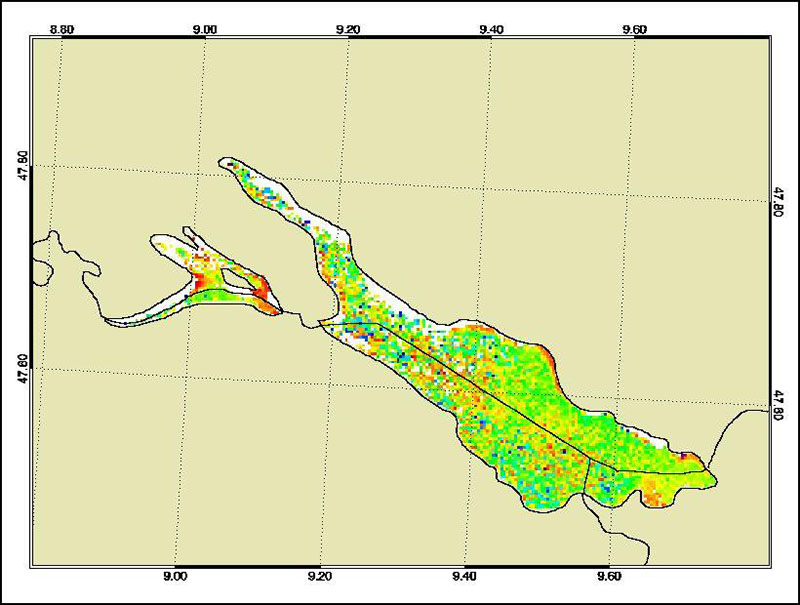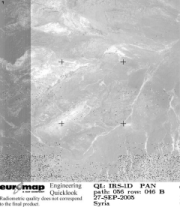Keyword
FEDEO
54 record(s)
Provided by
Type of resources
Available actions
Topics
Keywords
Contact for the resource
Update frequencies
-

The Medium Resolution Imaging Spectrometer (MERIS) on Board ESA’s ENVISAT provides spectral high resolution image data in the visible-near infrared spectral region (412-900 nm) at a spatial resolution of 300 m. For more details on ENVISAT and MERIS see http://envisat.esa.int/ This product developed in the frame of the MAPP project (MERIS Application and Regional Products Projects) represents the chlorophyll concentration of Lake Constance derived from MERIS data. The product is a cooperative effort of DLR-DFD and the Institute for Coastal Research at the GKSS Research Centre Geesthacht. DFD pre-processed up to the value added level whenever MERIS data for the North Sea region was received and positively checked for a water area large enough for a suitable interpretation. For more details the reader is referred to http://wdc.dlr.de/sensors/meris/ and http://wdc.dlr.de/sensors/meris/documents/Mapp_ATBD_final_i3r0dez2001.pdf This product provides monthly maps.
-

This product consists of global gap free Leaf area index (LAI) time series, based on MERIS full resolution Level 1B data. It is produced as a series of 10-day composites in geographic projection at 300m spatial resolution. The processing chain comprises geometric correction, radiometric correction and pixel identification, LAI calculation with the BEAM MERIS vegetation processor, re-projection to a global grid, and temporal aggregation selecting the measurement closest to the mean value. After the LAI pre-processing we applied time series analysis to fill data gaps and filter outliers using the technique of harmonic analysis in combination with mean annual and multiannual phenological data. Data gaps are caused by clouds, sensor limitations due to the solar zenith angle (less than 10 degrees), topography and intermittent data reception. We applied our technique for the whole period of observation (Jul 2002 - Mar 2012). Validation, was performed using VALERI and BigFoot data.
-

The "AVHRR compatible Normalized Difference Vegetation Index derived from MERIS data (MERIS_AVHRR_NDVI)" was developed in a co-operative effort of DLR (German Remote Sensing Data Centre, DFD) and Brockmann Consult GmbH (BC) in the frame of the MAPP project (MERIS Application and Regional Products Projects). For the generation of regional specific value added MERIS level-3 products, MERIS full-resolution (FR) data are processed on a regular (daily) basis using ESA standard level-1b and level-2 data as input. The regular reception of MERIS-FR data is realized at DFD ground station in Neustrelitz. The Medium Resolution Imaging MERIS on Board ESA's ENVISAT provides spectral high resolution image data in the visible-near infrared spectral region (412-900 nm) at a spatial resolution of 300 m. For more details on ENVISAT and MERIS see http://envisat.esa.int The Advanced Very High Resolution Radiometer (AVHRR) compatible vegetation index (MERIS_AVHRR_NDVI) derived from data of the MEdium Resolution Imaging Spectrometer (MERIS) is regarded as a continuity index with 300 meter resolution for the well-known Normalized Difference Vegetation Index (NDVI) derived from AVHRR (given in 1km spatial resolution). The NDVI is an important factor describing the biological status of canopies. This product is thus used by scientists for deriving plant and canopy parameters. Consultants use time series of the NDVI for advising farmers with best practice. For more details the reader is referred to http://wdc.dlr.de/sensors/meris/ and http://wdc.dlr.de/sensors/meris/documents/Mapp_ATBD_final_i3r0dez2001.pdf This product provides 10-days maps.
-

The Medium Resolution Imaging Spectrometer (MERIS) on Board ESA’s ENVISAT provides spectral high resolution image data in the visible-near infrared spectral region (412-900 nm) at a spatial resolution of 300 m. For more details on ENVISAT and MERIS see http://envisat.esa.int/ This product developed in the frame of the MAPP project (MERIS Application and Regional Products Projects) represents the chlorophyll concentration of the North Sea derived from MERIS data. The product is a cooperative effort of DLR-DFD and the Institute for Coastal Research at the GKSS Research Centre Geesthacht. DFD pre-processed up to the value added level whenever MERIS data for the North Sea region was received and positively checked for a water area large enough for a suitable interpretation. For more details the reader is referred to http://wdc.dlr.de/sensors/meris/ and http://wdc.dlr.de/sensors/meris/documents/Mapp_ATBD_final_i3r0dez2001.pdf This product provides 10-day maps.
-

The "AVHRR compatible Normalized Difference Vegetation Index derived from MERIS data (MERIS_AVHRR_NDVI)" was developed in a co-operative effort of DLR (German Remote Sensing Data Centre, DFD) and Brockmann Consult GmbH (BC) in the frame of the MAPP project (MERIS Application and Regional Products Projects). For the generation of regional specific value added MERIS level-3 products, MERIS full-resolution (FR) data are processed on a regular (daily) basis using ESA standard level-1b and level-2 data as input. The regular reception of MERIS-FR data is realized at DFD ground station in Neustrelitz. The Medium Resolution Imaging MERIS on Board ESA's ENVISAT provides spectral high resolution image data in the visible-near infrared spectral region (412-900 nm) at a spatial resolution of 300 m. For more details on ENVISAT and MERIS see http://envisat.esa.int The Advanced Very High Resolution Radiometer (AVHRR) compatible vegetation index (MERIS_AVHRR_NDVI) derived from data of the MEdium Resolution Imaging Spectrometer (MERIS) is regarded as a continuity index with 300 meter resolution for the well-known Normalized Difference Vegetation Index (NDVI) derived from AVHRR (given in 1km spatial resolution). The NDVI is an important factor describing the biological status of canopies. This product is thus used by scientists for deriving plant and canopy parameters. Consultants use time series of the NDVI for advising farmers with best practice. For more details the reader is referred to http://wdc.dlr.de/sensors/meris/ and http://wdc.dlr.de/sensors/meris/documents/Mapp_ATBD_final_i3r0dez2001.pdf This product provides monthly maps.
-

The Medium Resolution Imaging Spectrometer (MERIS) on Board ESA’s ENVISAT provides spectral high resolution image data in the visible-near infrared spectral region (412-900 nm) at a spatial resolution of 300 m. For more details on ENVISAT and MERIS see http://envisat.esa.int/ Spectral high resolution measurements allow to assess different water constituents in optically complex case-2 waters (IOCCG, 2000). The main groups of constituents are Chlorophyll, corresponding to living phytoplankton, suspended minerals or sediments and dissolved organic matter. They are characterised by their specific inherent optical properties, in particular scattering and absorption spectra. The Baltic Sea Water Constituents product was developed in a co-operative effort of DLR (Remote Sensing Technology Institute IMF, German Remote Sensing Data Centre DFD), Brockmann Consult (BC) and Baltic Sea Research Institute (IOW) in the frame of the MAPP project (MERIS Application and Regional Products Projects). The data are processed on a regular (daily) basis using ESA standard Level-1 and -2 data as input and producing regional specific value added Level-3 products. The regular data reception is realised at DFD ground station in Neustrelitz. For more details the reader is referred to http://wdc.dlr.de/sensors/meris/ and http://wdc.dlr.de/sensors/meris/documents/Mapp_ATBD_final_i3r0dez2001.pdf This product provides 10-day maps.
-

Indian Remote Sensing satellites (IRS) are a series of Earth Observation satellites, built, launched and maintained by Indian Space Research Organisation. The IRS series provides many remote sensing services to India and international ground stations. IRS LISS-III data are well suited for agricultural and forestry monitoring tasks. Because of their simultaneous acquisition with IRS PAN data and the availability of a synthetic blue band, LISS-III data are ideal for colouring IRS PAN products.
-

The Medium Resolution Imaging Spectrometer (MERIS) on Board ESA’s ENVISAT provides spectral high resolution image data in the visible-near infrared spectral region (412-900 nm) at a spatial resolution of 300 m. For more details on ENVISAT and MERIS see http://envisat.esa.int/ This product developed in the frame of the MAPP project (MERIS Application and Regional Products Projects) represents the chlorophyll concentration of Lake Constance derived from MERIS data. The product is a cooperative effort of DLR-DFD and the Institute for Coastal Research at the GKSS Research Centre Geesthacht. DFD pre-processed up to the value added level whenever MERIS data for the North Sea region was received and positively checked for a water area large enough for a suitable interpretation. For more details the reader is referred to http://wdc.dlr.de/sensors/meris/ and http://wdc.dlr.de/sensors/meris/documents/Mapp_ATBD_final_i3r0dez2001.pdf This product provides daily maps.
-

Indian Remote Sensing satellites (IRS) are a series of Earth Observation satellites, built, launched and maintained by Indian Space Research Organisation. The IRS series provides many remote sensing services to India and international ground stations. \\n\\nIRS LISS-III data are well suited for agricultural and forestry monitoring tasks. Because of their simultaneous acquisition with IRS PAN data and the availability of a synthetic blue band, LISS-III data are ideal for colouring IRS PAN products.
-

Indian Remote Sensing satellites (IRS) are a series of Earth Observation satellites, built, launched and maintained by Indian Space Research Organisation. The IRS series provides many remote sensing services to India and international ground stations. With 5 m resolution and products covering areas up to 70 km x 70 km IRS PAN data provide a cost effective solution for mapping tasks up to 1:25'000 scale.
 www.geodatenkatalog.de (S1L)
www.geodatenkatalog.de (S1L)